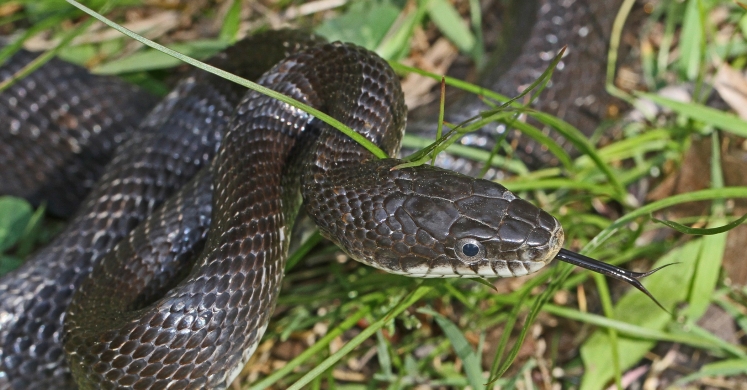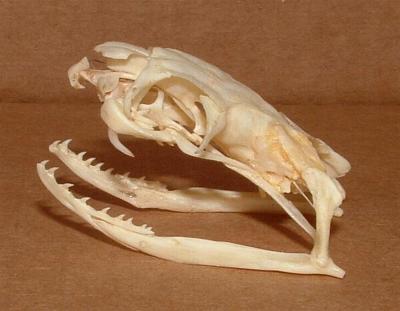Blog

#bioPGH Blog: Eastern Black Rat Snake
 A resource of Biophilia: Pittsburgh, #bioPGH is a weekly blog and social media series that aims to encourage both children and adults to reconnect with nature and enjoy what each of our distinctive seasons has to offer.
A resource of Biophilia: Pittsburgh, #bioPGH is a weekly blog and social media series that aims to encourage both children and adults to reconnect with nature and enjoy what each of our distinctive seasons has to offer.
If you’ve ever seen a six-foot snake slithering up a tree in Pennsylvania, your heart rate likely started racing, but it was probably just a black rat snake—harmless to humans and in a way, even helpful. Snakes are often feared and carry a negative stigma (think Slytherin House), but many of their attributes are simply misunderstood—they really are fascinating creatures! So right now, whether your skin is crawling with nerves or you’ve settled in to read with a cup of tea, let’s learn a little bit more about our local herp the black rat snake.
Black rat snakes are quite good tree climbers.
Black rat snakes are a fairly common species across the eastern half of the US, ranging as far south as Florida and as far north as Vermont. They can be found in a variety of habitats, including different types of forests and farm lands—which is quite convenient since their most common prey (rodents) can be an agricultural nuisance. Black rat snakes are constrictors, which means they kill their prey by constricting (squeezing) them until the prey can’t breathe in and, thus, suffocate. Aside from rodents, they will also eat birds and bird eggs when they have the opportunity.
If you happen to spot a snake in the wild, there are a few ways to identify if it’s a black rat snake. Adults can be two to six feet long, though the record stands at over eight feet. While older adults are dark with usually only a faintly visible pattern, juveniles have very distinct blotchy coloration pattern that helps them camouflage (the Virginia Herpetological Society has great breakdown of coloration at different ages.)
In spite of their utility in maintaining rodent populations, black rat snakes share some of the same burden as snakes in general: confusion and misconceptions. One common misconception is that snakes can “unhinge” their jaws to eat. Rather than unhinging their jaws, though, snakes have a very different skull than humans do. For starters, they have more kinetic (movable) parts of their skull than us, which gives their mouths a wide range of motion. They also can open their jaw wide at the “chin,” which is held together by elastic tissue. Because of all of this skull flexibility, snakes don’t have the potential for muscle power that mammalian jaws do; but instead, snakes can swallow prey larger much than their heads, and their backwards-pointing teeth aid in gripping those prey.

Cobra skull—note how the lower jaw is actually formed by two bones that can expand outwards to accommodate larger food items.
Another misconception about snakes is that they are slimy, but they aren’t at all. This idea probably arose from the fact that many amphibians may feel “slimy” to the touch, but amphibians have specialized skin that they are trying to protect from desiccation (drying.) Snakes, on the other hand, have scales made of keratin—the same material as your fingernails and hair. While some snakes have smooth scales, other species scales are keeled, meaning each scale has a little ridge rising through the center.
The last misconception I’ll mention is more of a semantic quibble: there are very few poisonous snakes in the world, but there are numerous venomous snakes. A poison causes trouble through such means as ingestion or absorption, but venom is injected. If you or your pet were to eat or even lick certain toads or other amphibians, it could cause intense sickness or distress because the offending (or rather defending) amphibian was poisonous. On the hand, bees have venom, snakes have venom, male duck-billed platypuses have venom, etc.; and these organisms all inject their toxins into prey or a threat. Notice, though, there actually are a handful of poisonous snakes. Rather than producing their own toxins, though, these snakes become poisonous through their own diets if they are adapted to consume prey like some poisonous newts or frogs.
If snakes make you squeamish, you’re not alone. Snakes (and spiders) are consistently the most common fears in the world, and there is even evidence to suggest the fear is innate—something we’re born with, rather than something we’ve learned from others. What is important to remember is that snakes will leave you alone if you leave them alone. They aren’t looking to bother humans, and even venomous species would much rather save their costly venom for catching dinner rather than waste it on you. That said, all animals deserve a healthy respect and distance—even black rat snakes will respond defensively when cornered. However, we don’t need to fear snakes above any other animal. Everything living thing is important in the food web, including snakes!
Note: Taxonomy research over the last century led to a bit of species confusion with Pantherophis alleghaniensis, the eastern ratsnake or eastern black rat snake. To see a list of all 34 previous scientific names, check out the Florida Museum of Natural History website.
Connecting to the Outdoors Tip: These snakes are quite common in Pennsylvania. Snakes are easiest to spot when they are basking in the sun to stay warm—sometimes in the middle of trails or on rocks or logs in direct sunlight.
Continue the Conversation: Share your nature discoveries with our community by posting to Twitter and Instagram with hashtag #bioPGH, and R.S.V.P. to attend our next Biophilia: Pittsburgh meeting.
Virginia Herpetological Society –Black Rat Snakes
National Geographic—Are We Born Fearing Spiders and Snakes?
Photo credits: Wikimedia user Richinpequea CC-BY-SA-3.0 (snake climbing a tree), Mokele CC-BY-SA-3.0 (cobra skull), Judy Gallagher CCY-BY-2.0 (cover)


